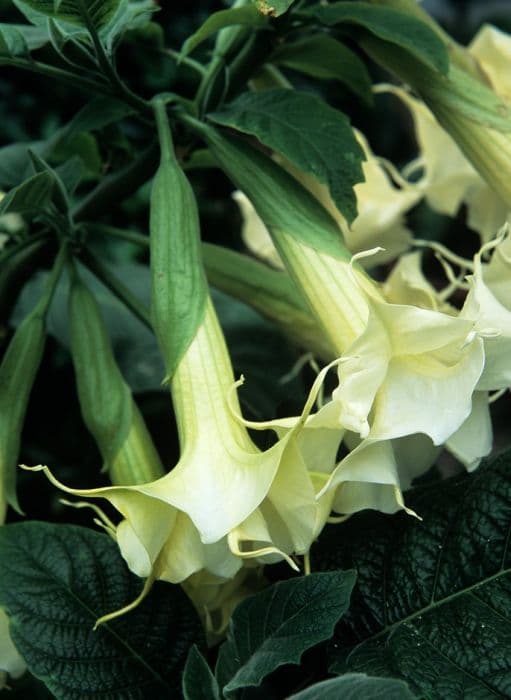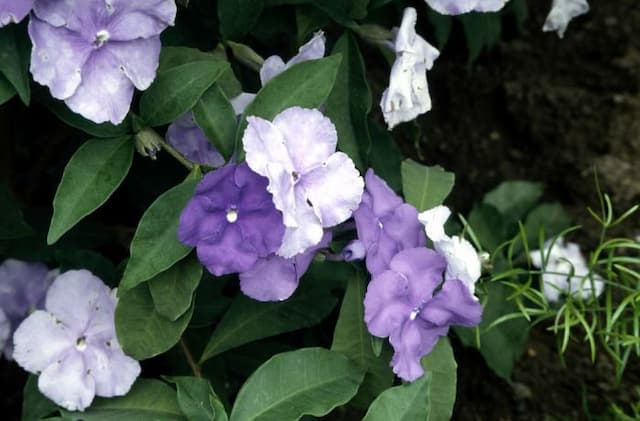Million Bells Calibrachoa Callie Mango = 'Cal Mang' (Callie Series)
![calibrachoa [Callie Mango]](/_next/image?url=https%3A%2F%2Fplants-admin.emdemapps.com%2Fimages%2Fplants%2F%2Fimages%2F604b6514b1579.png&w=3840&q=75)
ABOUT
The Calibrachoa Callie Mango, part of the Callie Series, is a vibrant and showy plant known for its striking flowers. The blossoms of the Callie Mango are trumpet-shaped and boast a bold mango-orange hue, providing a warm and tropical feel to any garden or container. Each flower features delicate shading and may have a faintly darker throat, which gives them depth and highlights the funnel form of the petals. The foliage of the Callie Mango is typically a bright, healthy green, creating a lush backdrop for the profusion of orange flowers. The leaves are small to medium in size and have a smooth texture, with slightly pointed tips. The overall growth habit of this plant is cascading or slightly mounding, making it an excellent choice for hanging baskets, window boxes, and as a spiller plant in mixed containers. Owing to its prolific blooming nature, the Callie Mango can provide a continuous display of vibrant flowers throughout the growing season. The plant is also known for its resilience and low maintenance requirements, making it a favorite among both novice and experienced gardeners. Despite the constraint on detailing the plant's size, it's clear that the Calibrachoa Callie Mango would serve as a colorful and vivacious addition to any floral arrangement or garden setting.
About this plant
 Names
NamesFamily
Solanaceae
Synonyms
Superbells, Million Bells, Mini Petunia, Seaside Petunia, Trailing Petunia
Common names
Calibrachoa Callie Mango = 'Cal Mang' (Callie Series).
 Toxicity
ToxicityTo humans
Calibrachoa, commonly known as million bells, is generally not known to be toxic to humans. However, as with many ornamental plants, it is not intended for consumption. If ingested, it could potentially cause mild gastrointestinal discomfort including nausea, vomiting, or diarrhea. It is always advisable to keep ornamental plants out of reach of children who might accidentally ingest plant material.
To pets
Million bells, the common name for Calibrachoa, is not listed as a toxic plant for pets by major animal poison control resources. However, it is always wise to prevent pets from ingesting this or any non-food plants as they could potentially cause gastrointestinal upset such as vomiting or diarrhea in some animals. If a pet ingests a significant amount of the plant and shows signs of distress, contacting a veterinarian is recommended.
 Characteristics
CharacteristicsLife cycle
Annuals
Foliage type
Evergreen
Color of leaves
Green
Flower color
Mango
Height
6-12 inches (15-30 cm)
Spread
12-24 inches (30-60 cm)
Plant type
Herb
Hardiness zones
9
Native area
South America
Benefits
 General Benefits
General Benefits- Vibrant Colors: Adds visual appeal to gardens and landscapes with its bright, mango-colored flowers.
- Continuous Blooming: Offers a long blooming season, generally from spring to frost, providing consistent color.
- Low Maintenance: Requires minimal care, making it a convenient choice for gardeners of all skill levels.
- Heat Tolerance: Thrives in hot weather, ideal for sunny locations that may challenge other plants.
- Drought Resistance: Once established, it can tolerate periods of low water, which is beneficial in water-wise gardening.
- Compact Growth: With its mounding and trailing habit, it's excellent for use in containers, hanging baskets, and window boxes.
- Attracts Pollinators: The flowers can attract hummingbirds and butterflies, benefiting the local ecosystem.
 Medical Properties
Medical PropertiesThis plant is not used for medical purposes.
 Air-purifying Qualities
Air-purifying QualitiesThis plant is not specifically known for air purifying qualities.
 Other Uses
Other Uses- Photography Subjects: With its vibrant orange blossoms, the Calibrachoa can be used as a beautiful subject for macro and botanical photography.
- Education Material: It can be used as a living example in botany classes to illustrate plant growth, pollination, and hybridization concepts.
- Artistic Inspiration: Artists may use the intense colors and delicate forms of the Calibrachoa blossoms as inspiration for paintings, illustrations, and textile designs.
- Sensory Gardens: Its textured leaves and colorful flowers make it a suitable plant for sensory gardens, designed to be enjoyed through touch and sight.
- Eco-Friendly Confetti: Dried petals of the Calibrachoa can be used as biodegradable confetti for outdoor celebrations, reducing environmental impact.
- Nature Crafts: The flowers and leaves can be used in crafting, such as pressing for bookmarks or making floral arrangements.
- Marriage Proposals: As a symbol of warmth and joy, the Calibrachoa could be planted to create a vibrant backdrop for outdoor marriage proposals.
- Gifting: A potted Calibrachoa can serve as a thoughtful living gift, symbolizing growing love and care when given to friends or family.
- Thematic Decorations: The plant can be used as part of themed decor, for instance in events or venues that are meant to evoke a tropical or sunny atmosphere.
- Color Therapy: The bright orange hue of the Calibrachoa flowers can be used in color therapy practices to evoke feelings of energy and creativity.
Interesting Facts
 Feng Shui
Feng ShuiThe Million Bells is not used in Feng Shui practice.
 Zodiac Sign Compitability
Zodiac Sign CompitabilityThe Million Bells is not used in astrology practice.
 Plant Symbolism
Plant Symbolism- Joyfulness: Calibrachoa often symbolizes joy due to its vibrant and lively colors that can brighten up any garden space or home.
- Entertainment: Calibrachoa, with its proliferation of flowers, suggests a sense of amusement and lighthearted fun, reminiscent of festivities and celebrations.
- Innovation: Given the hybrid nature of the 'Calibrachoa Callie Mango,' it can represent creativity and the spirit of innovation in horticulture.
- Flexibility: Calibrachoa is adaptable to various environments, symbolizing flexibility and the ability to thrive in changing conditions.
- Growth: This plant's ease of growth and care may symbolize personal growth and the nurturing of one’s own developmental endeavors.
 Water
WaterMillion Bells should be watered regularly to maintain a consistently moist soil environment, without becoming waterlogged. It is important to water thoroughly when the top 1 inch of soil feels dry to the touch. Depending on weather conditions, this may mean watering once every few days to every week. Generally, during hot summer days, watering may be necessary daily, using about 1 gallon per plant per week. It is best to water in the morning to allow foliage to dry before evening. Be sure not to overwater, as this can lead to root rot.
 Light
LightMillion Bells thrives best in full sun, meaning it should receive at least 6 to 8 hours of direct sunlight per day. The ideal spot for the plant is one where it can bask in the morning sun and can be protected from the intense afternoon heat if necessary. Partial shade in the afternoon can help to prevent scorching in regions with very high temperatures.
 Temperature
TemperatureMillion Bells prefers warm temperatures and will perform best when daytime temperatures are between 55 and 85 degrees Fahrenheit. However, it can tolerate temperatures as low as 40 degrees at night and as high as 90 degrees during the day, but growth may slow if temperatures exceed this range. The plant can perish if exposed to frost, so it is essential to ensure that the minimum temperature does not fall below 40 degrees Fahrenheit.
 Pruning
PruningPruning Million Bells is essential for encouraging bushier growth and more blooms. It should be pruned lightly throughout the growing season whenever the plant begins to look leggy or sparse. Cutting back by a few inches every few weeks can stimulate new growth and flower production. The best time for major pruning is in the early spring, before the onset of the new growing season.
 Cleaning
CleaningAs needed
 Soil
SoilMillion Bells thrive in well-draining soil with a mix of peat, potting soil, and perlite or sand. Soil pH should be slightly acidic to neutral, between 5.5 and 6.5.
 Repotting
RepottingMillion Bells should be repotted annually to refresh the soil, as they are typically grown as annuals and may not require multiple repotting sessions.
 Humidity & Misting
Humidity & MistingMillion Bells prefer moderate humidity levels and can tolerate the average ambient humidity found in outdoor environments.
 Suitable locations
Suitable locationsIndoor
Place Million Bells in bright, indirect light and avoid overwatering.
Outdoor
Plant in full sun to part shade and protect from strong winds.
Hardiness zone
9-11 USDA
 Life cycle
Life cycleThe life cycle of Calibrachoa 'Callie Mango' (Calibrachoa hybrid) begins with germination, where the seeds sprout and develop into small seedlings when exposed to the appropriate temperatures and moisture levels. In the vegetative stage, the plant grows leaves and stems vigorously, establishing a strong root system. As it enters the flowering stage, which can occur within a few weeks of planting, the plant produces vibrant mango-colored flowers, continuously blooming throughout the warm months. Following pollination, which is often facilitated by insects, the plant may produce small seed pods, although many hybrid varieties are sterile and propagated through cuttings. As the temperatures drop in late fall or early winter, unless in a controlled environment, growth slows and flowering diminishes, signaling the plant's entry into dormancy or, in some climates, it may die if frost occurs. Lastly, for perennial growth, with the return of favorable conditions, the plant resumes growth, completing its cycle.
 Propogation
PropogationPropogation time
Spring-Early Summer
Calibrachoa Callie Mango, often known simply as Calibrachoa or trailing petunia, is best propagated through cuttings. The optimal time for taking cuttings for propagation is in late spring to early summer when the plant is actively growing. To propagate through cuttings, a gardener should select a healthy stem with no flower buds, cutting a segment about 4 to 6 inches long. The lower leaves are removed, leaving only two to three pairs at the top. The cut end is then dipped in rooting hormone to encourage root development and placed in a well-draining soil mix, moistened but not waterlogged. Typically, rooting occurs within a few weeks, after which the young plants can be transplanted to their final location. It's important to maintain a humid environment for the cuttings by covering them with a clear plastic bag or placing them in a propagator until they root.









